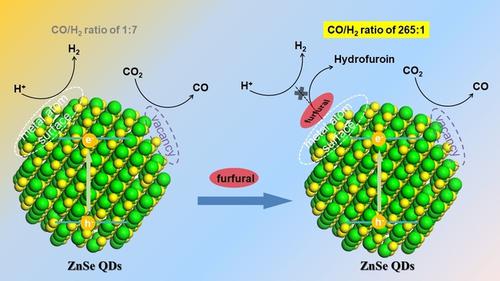当前位置:
X-MOL 学术
›
Angew. Chem. Int. Ed.
›
论文详情
Our official English website, www.x-mol.net, welcomes your feedback! (Note: you will need to create a separate account there.)
Reductive Carbon–Carbon Coupling on Metal Sites Regulates Photocatalytic CO2 Reduction in Water Using ZnSe Quantum Dots
Angewandte Chemie International Edition ( IF 16.6 ) Pub Date : 2022-05-29 , DOI: 10.1002/anie.202207222 Zhi-Kun Xin 1, 2 , Mao-Yong Huang 1 , Yang Wang 1 , Yu-Ji Gao 1 , Qing Guo 1 , Xu-Bing Li 1, 2 , Chen-Ho Tung 1, 2 , Li-Zhu Wu 1, 2
Angewandte Chemie International Edition ( IF 16.6 ) Pub Date : 2022-05-29 , DOI: 10.1002/anie.202207222 Zhi-Kun Xin 1, 2 , Mao-Yong Huang 1 , Yang Wang 1 , Yu-Ji Gao 1 , Qing Guo 1 , Xu-Bing Li 1, 2 , Chen-Ho Tung 1, 2 , Li-Zhu Wu 1, 2
Affiliation

|
Reductive carbon–carbon coupling was used to block H2 evolution in CO2 photoreduction in water. Furfural, one of the biomass platform molecules, adsorbs on Zn-sites consuming electrons and protons originally used for H2 production, but the CO formation pathway at surface anion vacancies remains. Therefore, CO was evolved with a CO/H2 ratio of 265 : 1 in the gas phase and furfural was upgraded to value-added hydrofuroin.
中文翻译:

金属位点上的还原性碳-碳耦合利用 ZnSe 量子点调节水中的光催化 CO2 还原
还原性碳-碳耦合用于阻止水中CO 2光还原中的H 2释放。糠醛是生物质平台分子之一,吸附在消耗电子和质子的锌位点上,这些电子和质子最初用于生产 H 2,但表面阴离子空位处的 CO 形成途径仍然存在。因此,在气相中以 265:1 的 CO/H 2比生成 CO,并将糠醛升级为增值氢呋喃。
更新日期:2022-05-29
中文翻译:

金属位点上的还原性碳-碳耦合利用 ZnSe 量子点调节水中的光催化 CO2 还原
还原性碳-碳耦合用于阻止水中CO 2光还原中的H 2释放。糠醛是生物质平台分子之一,吸附在消耗电子和质子的锌位点上,这些电子和质子最初用于生产 H 2,但表面阴离子空位处的 CO 形成途径仍然存在。因此,在气相中以 265:1 的 CO/H 2比生成 CO,并将糠醛升级为增值氢呋喃。



























 京公网安备 11010802027423号
京公网安备 11010802027423号